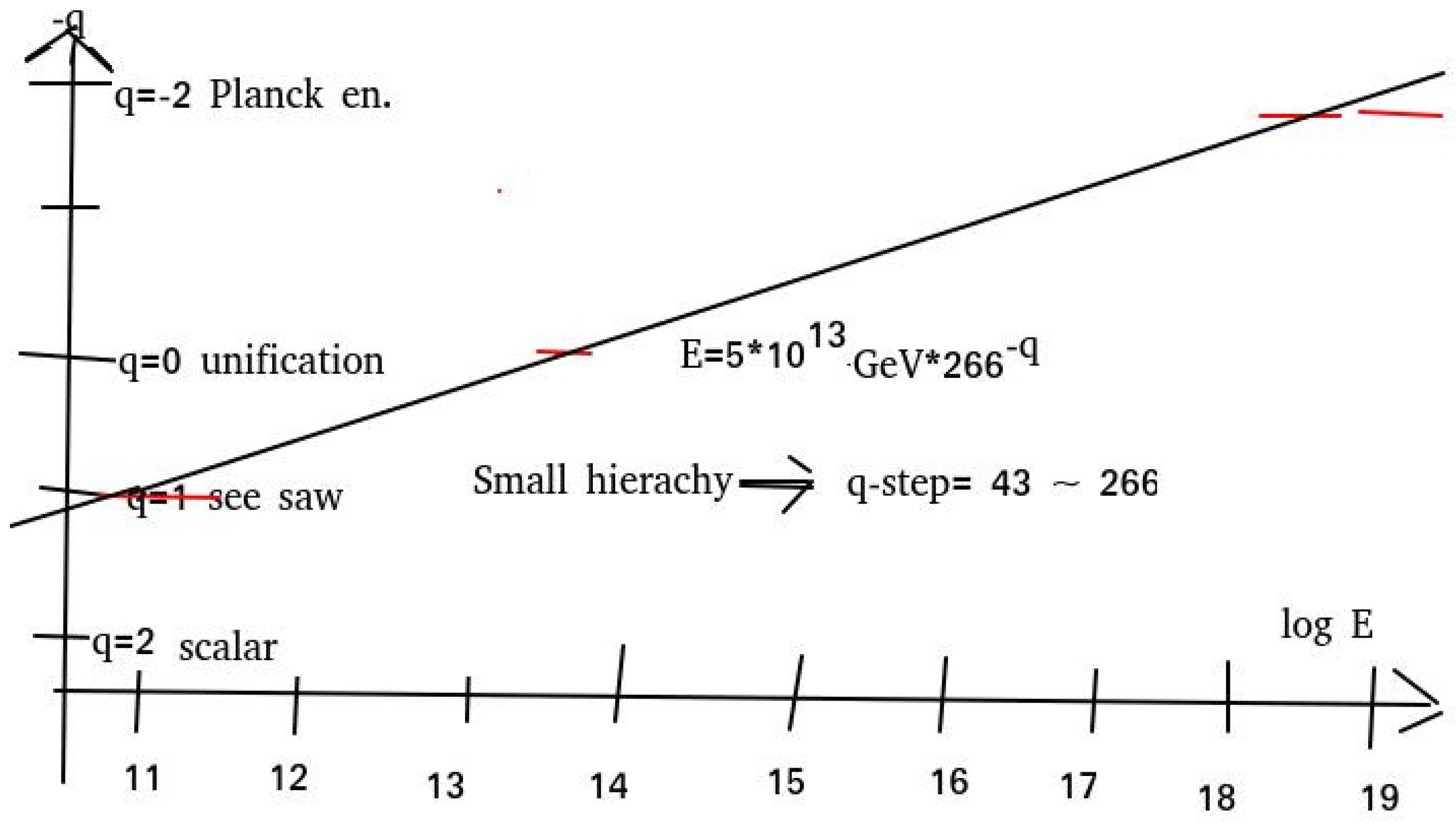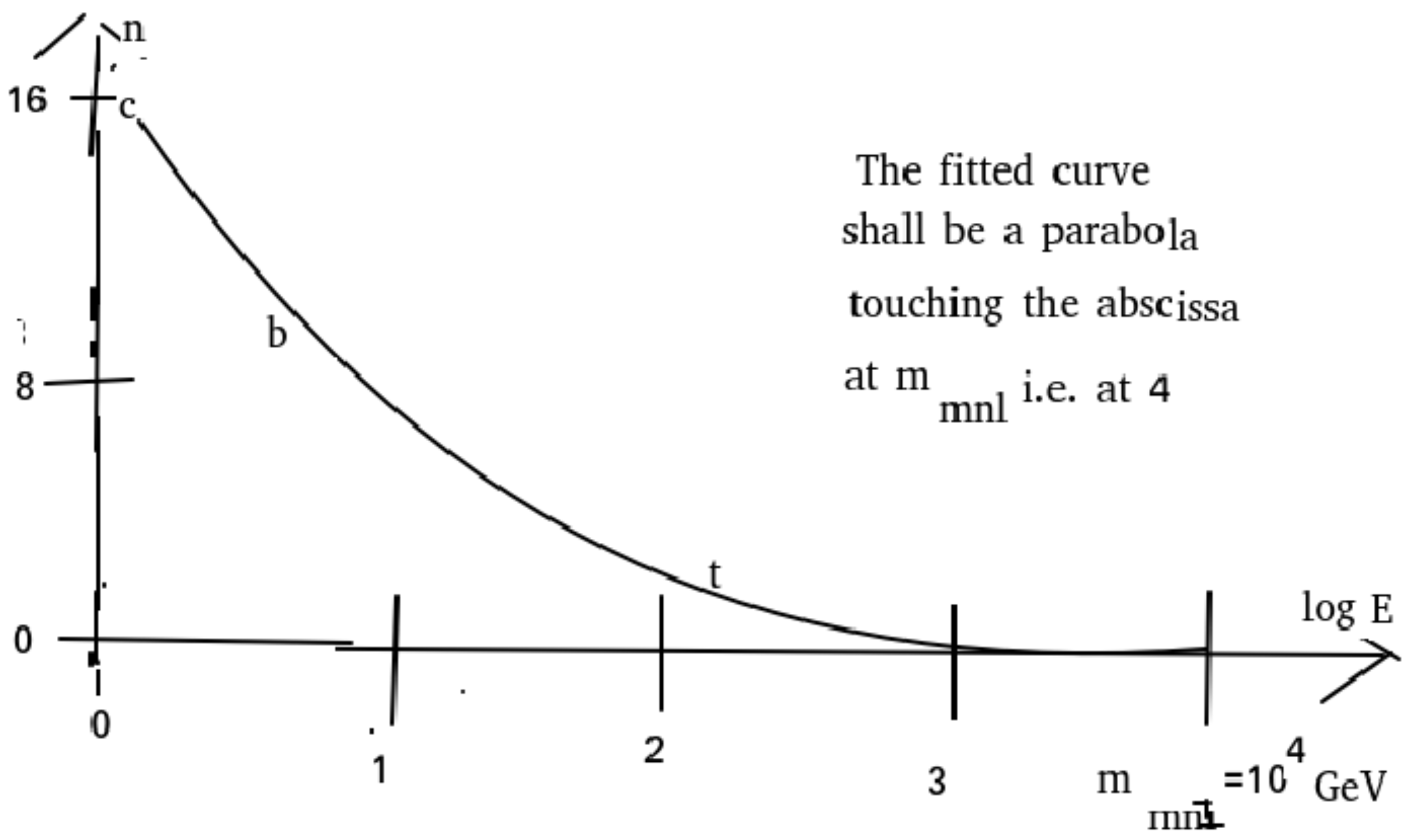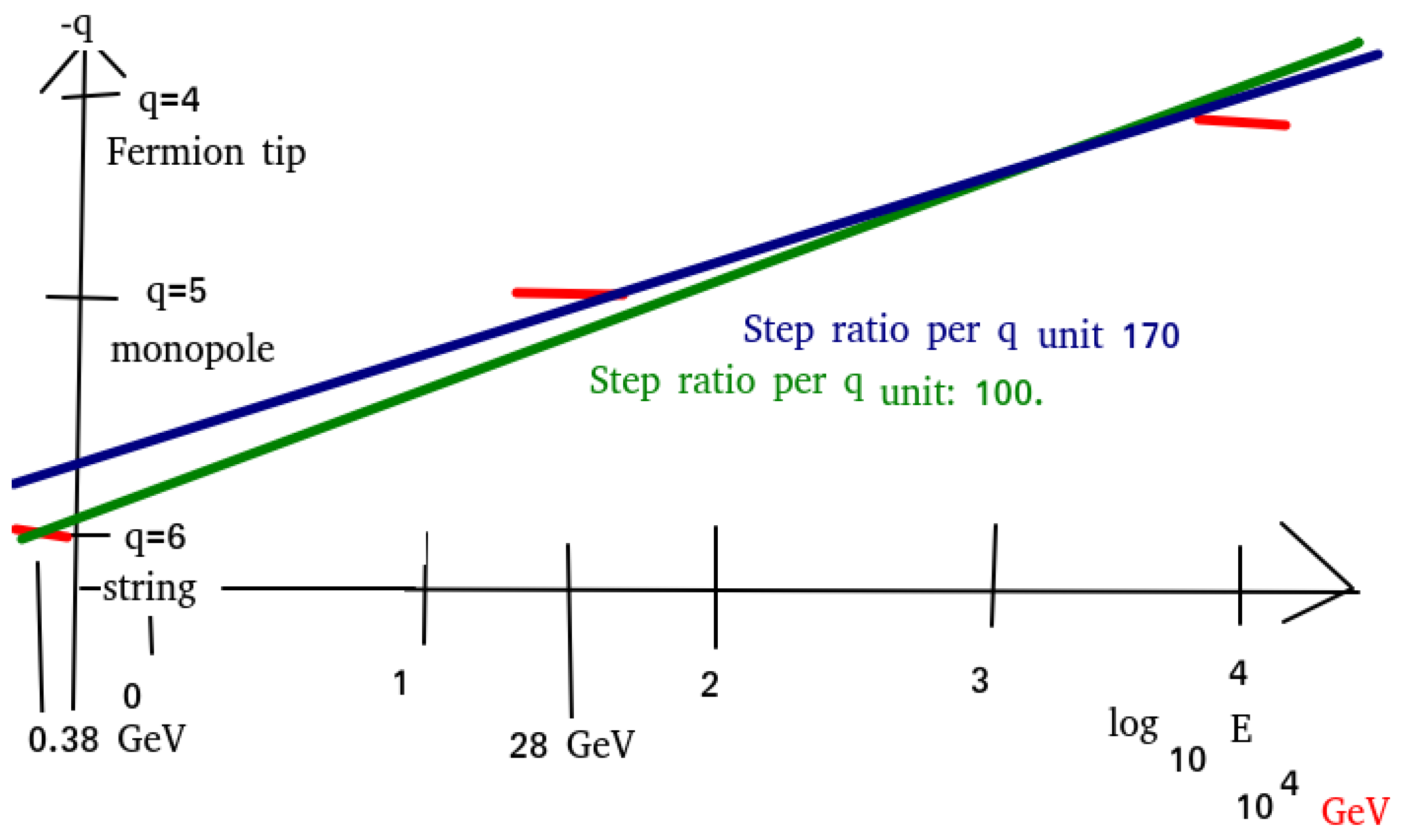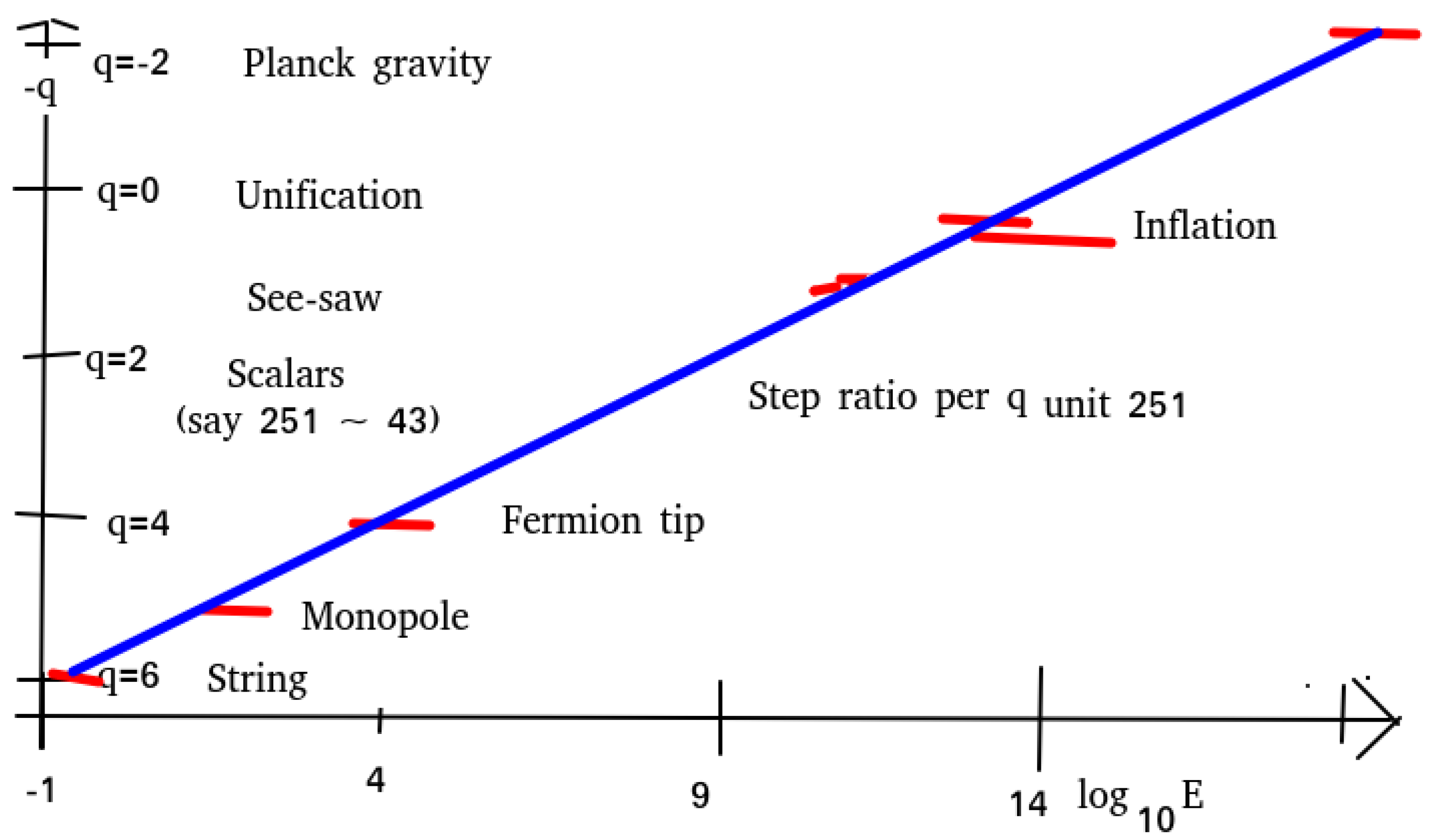Remarkable Scale Relation, Approximate SU(5), Fluctuating Lattice
Abstract
1. Introduction
1.1. A Few Works Involving Similar Matters
1.2. A Pedagogical Example
1.3. Outline
2. Definition of a Dimensionality Quantity and Fluctuating Lattice Model
2.1. On the Variation of Actions Under a, Fluctuations in Fluctuating Lattice
2.2. Effect of Strong Fluctuations on Averages
2.2.1. Motivation for the Gaussian Distribution in the Logarithm
2.2.2. “Unification Scale”
2.2.3. Postponing Three Scales
3. Our Main Table
3.1. Explanation of the Table
Content in the Different Columns
- The first column (from left) contains three items:
- 1.
- A name, which we just ascribe to the scale in question.
- 2.
- An allusion from, which data the energy scale is determined.
- 3.
- What we call “status”, an estimation of how reliable the story of the scale in question is.
- In the second column, the items are as follows:
- 1.
- : This is the dimensionality of the coefficient to a term in the Lagrangian relevant for the interaction regarding the scale in question. In the table, either “ìn kin.t.” or “in non-kin.” is added, meaning that the term with the coefficient of the dimension given is the kinetic term or the non-kinetic term, respectively.
- 2.
- The next line inside column 2 has the quantity q and its value for the scale in question written, or some effective value for this q. For non-kin. , while for “kin.t.”, it is , because we have, in all of the cases (by accident), the other coefficient as dimensionless.
- Then, the third column shows the values obtained for the energy scale.
- 1.
- In the top line inside the blocks has the experimental data, or rather the best theoretical estimate from the experimental data. This type of data is mentioned in the second line in column 1.
- 2.
- In the next line, we have put the value from the straight line fit to the logarithm of the energy versus q. It is given by the fitting formula:
- In the fourth column, we have the following items:
- 1.
- In the first line is a reference to the formula in the text representing the decision as to what value to take for the scale in question (usually by most trustworthy in order of magnitude).
- 2.
- In the second line is the Lagrangian density used in determining the dimension of its coefficient, .
- 3.
- In the third line, we put some formula or remark, which is supposed to make recognizable what the Lagrangian density in line 2 means.
4. Discussions of the Several Different Scales
4.1. The Four Highest and Simplest to Discuss Scales
4.1.1. Planck Scale
4.1.2. (Approximate) Unification Scale
4.1.3. See-Saw Scale
4.1.4. The Scalar Scale
4.1.5. Straight Line Relation for the “Simplest Upper Four”
4.2. The More Complicated Scales
The Inflation Scale
- LiddleAs a scale to represent the energy scale for the inflation period of the universe we may—perhaps in a bit of a biased way—choose the Hubble–Lemaitre expansion at the end of the inflation which, according to Andrew Liddle [49], takes values likeUsing the values GeV or GeV for , we obtain values for likeIn fact, the highest of these results for is only a factor 7 lower than the “unification” scale GeV, and that is not even one order of magnitude.
- EnquistTaking a typical (but not necessarily correct) valueEnquist’s value for H is a factor of 2 above the “unification” scale. So, we can indeed claim, as our model predicts, that the scales of unification and inflation coincide in order of magnitude. Liddle’s value for the inflation scale is below, and Enquist’s value is above the unification scale.
- Belleomo et al.In the article by Belleomo et al. [50], we findHere, r is the ratio of the tensor spectrum to the scalar one
- LiddleLiddle [49] gives a value
4.3. The Three Lowest Energy Scales
- One way to average is simply to count all lattice hypercubes equally regardless of whether they happen to be big or small in the fluctuating lattice.
- Another method consists in analyzing their effect in what is a little finite or perhaps infinitesimal piece of space-time, because that is what will appear as the effect from a certain little region in space time. Now, if the lattice is locally dense, which means if a is small, then a higher number of hypercubes are counted in a given small region. And oppositely, when the lattice has big plaquettes, only a few hypercubes are counted in a small region. The factor by which we overcount, by asking for the contribution to a given little region, is, of course, proportional to . This factor is the same for the kinetic and the non-kinetic terms discussed for the first four “simple” scales, and thus this makes no difference to them. But this means that had we asked for an absolute value of a term in the Lagrangian, then we should use an average with included.So, when we denoted the “genuine” average link size by above, it was, in fact, an average using a weighting.
4.3.1. The Fermion Tip Scale
- wW extrapolate to the tip whatever distribution may fit the Standard Model masses;
- This tip point represents the maximum density of lattice hypercubes obtained by simple counting (not using field theory). It is this fact that leads to it having
| Name | number n | Mass m | = | |||
| top | 3 ± 1 | 172.76 ± 0.3 GeV | 2.2374 ± 0.0008 | 1.7626 | 3.1066 ± 0.003 | 1.0355 ± 0.001 ±0.4 |
| bottom | 9 ± 0.3 | 4.18 ± 0.0079 GeV | 0.6212 ± 0.001 | 3.3788 | 11.416 ± 0.01 | 1.268 ± 0.001 ± 0.03 |
| charm | 17 or 15 | 1.27 ± 0.02 | 0.10382 ± 0.009 | 3.8962 | 15.180 ± 0.07 | 0.893 ± 0.004 ± 0.06 |
| strange | 25 or 23 | 0.095 ± 0.006 GeV | −1.0223 ± 0.003 | 5.0223 | 25.223 ± 0.03 | 1.009 ± 0.001 ± 0.1 |
| down | 31 | 4.79 ± 0.16 MeV | −2.3197 ± 0.01 | 6.3197 | 39.939 ± 0.06 | 1.288 ± 0.002 |
| up | 37 | 2.01 ± 0.14 MeV | −2.6968 ± 0.03 | 6.6968 | 44.847 ± 0.4 | 1.212 ± 0.01 |
| Name | number n | Mass m | = | |||
| 13 or 19 | 1.77686 ± 0.00012 | 0.2496 ± 0.00003 | 3.7503 | 14.065 ± 0.0003 | 1.082 ± 0.00002 ±0.4 | |
| mu | 21 or 27 | 105.6583745 ± MeV | 4.9761 | 24.761 ± | 1.179 ± ± 0.3 | |
| electron | 41 | 0.51099895069 ± | −3.2915 ± | 7.2916 | 53.167 ± | 1.297 ± |
4.3.2. The Monopole Scale
4.3.3. The String Scale
4.3.4. Fit of the Low-Energy Scales
4.4. Total Fit Line
5. Fluctuating Gauge Argument for Fluctuating Lattice
6. Conclusions
6.1. Failures
6.2. Yet a Possible Scale?
Funding
Data Availability Statement
Acknowledgments
Conflicts of Interest
References
- Nielsen, H.B. Approximate SU(5), Fine structure constants. Universe 2025, 11, 32. [Google Scholar] [CrossRef]
- Howard, G.; Sheldon, G. Unity of All Elementary-Particle Forces. Phys. Rev. Lett. 1974, 32, 438. [Google Scholar] [CrossRef]
- Masiero, A.; Nanopoulos, A.; Tamvakis, K.; Yanagida, T. Naturally Massless Higgs Doublets in Supersymmetric SU(5). Phys. Lett. B 1982, 115, 380–384. [Google Scholar] [CrossRef]
- Laperashvili, L.; Ryzhikh, D. [SU(5)]3 SUSY unification. arXiv 2001, arXiv:hep-th/0112142. [Google Scholar]
- Senjanovic, G.; Zantedeschi, M. Minimal SU(5) theory on the edge: The importance of being effective. arXiv 2024, arXiv:2402.19224v1. [Google Scholar] [CrossRef]
- Nielsen, H.B.; Bennett, D. Seeking a Game in which the standard model Group shall Win. Bled Work. Phys. 2011, 12, 149. [Google Scholar]
- Nielsen, H.B. Small Representations Explaining, Why standard model group? PoS CORFU 2015, 2014, 045. [Google Scholar]
- Nielsen, H. Dimension Four Wins the Same Game as the Standard Model Group. Phys. Rev. D 2013, 88, 096001. [Google Scholar] [CrossRef]
- Nielsen, H.B. Random Dynamics and relations between the number of fermion generations and the fine structure constants. Acta Phys. Pol. Ser. B 1989, 20, 427. [Google Scholar]
- Cea, P.; Cosmai, L. Deconfinement phase transitions in external fields. In Proceedings of the XXIIIrd International Symposium on Lattice Field Theory, Trinity College, Dublin, Ireland, 25–30 July 2005. [Google Scholar]
- Laperashvili, L.V.; Ryzhikh, D.A.; Nielsen, H.B. Phase transition couplings in U(1) and SU(N) regularized gauge theories. Int. J. Mod. Phys. A 2001, 16, 3989–4009. [Google Scholar] [CrossRef]
- Laperashvili, L.V.; Nielsen, H.B.; Ryzhikh, D.A. Phase transition in gauge theories and multiple-point model. Phys. Atom. Nuclei 2002, 65, 353–364. [Google Scholar] [CrossRef]
- Das, C.R.; Froggatt, C.D.; Laperashvili, L.V.; Nielsen, H.B. Flipped SU(5), see-saw scale physics and degenerate vacua. arXiv 2005, arXiv:hep-ph/0507182. [Google Scholar]
- Nielsen, H.B.; Kleppe, A. Bled Workshop July 2019, “What comes Beyand the Standard Models”. Available online: http://bsm.fmf.uni-lj.si/bled2019bsm/talks/HolgerTransparencesconfusion2.pdf (accessed on 31 March 2025).
- Bennett, D.L.; Nielsen, H.B.; Brene, N.; Mizrachi, L. The Confusion Mechanism and the Heterotic String. In Proceedings of the 20th International Symposium on the Theory of Elementary Particles, Ahrenshoop, Germany, 13–17 October 1986. [Google Scholar]
- Minkowski, P. μ→eγ at a rate of one out of 109 muon decays? Phys. Lett. B 1977, 67, 421–428. [Google Scholar] [CrossRef]
- Mohapatra, R.N.; Senjanovic, G. Neutrino Mass and Spontaneous Parity Nonconservation. Phys. Rev. Lett. 1980, 44, 912. [Google Scholar] [CrossRef]
- Funkhouser, S. The fundamental scales of structures from first principles. arXiv 2008, arXiv:0804.2443. [Google Scholar]
- Stojkovic, D. Can We Push the Fundamental Planck Scale Above 1019 GeV? Available online: https://cds.cern.ch (accessed on 31 March 2025).
- Vergeles, S.N. Wilson fermion doubling phenomenon on irregular lattice: The similarity and difference with the case of regular lattice. arXiv 2015, arXiv:1502.03349v2. [Google Scholar] [CrossRef]
- Brockmann, R.; Frank, J. Lattice quantum hadrodynamics. Phys. Rev. Lett. 1992, 68, 1830. [Google Scholar] [CrossRef]
- Lüscher, M. Advanced Lattice QCD Desy 98-017 August 2006 (Lectures). Available online: https://luscher.web.cern.ch/luscher/lectures/LesHouches97.pdf (accessed on 31 March 2025).
- Wagner, A.J.; Strand, K. Fluctuating lattice Boltzmann method for the diffusion equation. Phys. Rev. E 2016, 94, 033302. [Google Scholar] [CrossRef][Green Version]
- Froggatt, C.D.; Nielsen, H.B. Hierarchy of quark masses, cabibbo angles and CP violation. Nucl. Phys. B 1979, 147, 277–298. [Google Scholar] [CrossRef]
- Foerster, D.; Nielsen, H.B.; Ninomiya, M. Dynamical stability of local gauge symmetry Creation of light from chaos. Phys. Lett. B 1980, 94, 135–140. [Google Scholar] [CrossRef]
- Kalecki, M. On the Gibrat Distribution. Econometrica 1945, 13, 161–170. [Google Scholar] [CrossRef]
- Pestieau, P.; Possen, U.M. A model of income distribtuion. Eur. Econ. Rev. 1982, 17, 279–294. [Google Scholar] [CrossRef]
- Johnson, N.L.; Kotz, S.; Balakrishnan, N. “14: Lognormal Distributions”, Continuous univariate distributions. In Wiley Series in Probability and Mathematical Statistics: Applied Probability and Statistics, 2nd ed.; John Wiley & Sons: New York, NY, USA, 1994; Volume 1, ISBN 978-0-471-58495-7. [Google Scholar]
- The CMS Collaboration. Search for resonances in the mass spectrum of muon pairs produced in association with b quark jets in proton-proton collisions at s = 8 and 13 TeV. arXiv 2018, arXiv:1808.01890v2.
- Volovik, G.E. Introduction: Gut and Anti-Gut; Oxford University Press: Oxford, UK, 2009; pp. 1–8. [Google Scholar] [CrossRef]
- Picek, I. Critical Couplings And Three Generations in a Random-Dynamics Inspired Model. Fizika B 1992, 1, 99–110. [Google Scholar]
- Bennett, D.; Nielsen, H.B.; Picek, I. Understanding fine structure constants and three generations. Phys. Lett. B 1988, 208, 275–280. [Google Scholar] [CrossRef]
- Nielsen, H.B.; Brene, N. Gauge Glass. In Proceedings of the XVIII International Symposium on the Theory of Elementary Particles, Ahrenshoop, Germany, 21–26 October 1984. [Google Scholar]
- Bennett, D.L.; Brene, N.; Mizrachi, L.; Nielsen, H.B. Confusing the heterotic string. Phys. Lett. B 1986, 178, 179–186. [Google Scholar] [CrossRef]
- Bennett, D.L.; Nielsen, H.B. Predictions for Nonabelian Fine Structure Constants from Multicriticality. arXiv 1993, arXiv:hep-ph/9311321v1. [Google Scholar]
- Bennett, D.L.; Nielsen, H.B. Gauge Couplings Calculated from Multiple Point Criticality Yield α−1 = 137 ± 9: At Last, the Elusive Case of U(1). arXiv 1996, arXiv:hep-ph/9607278. [Google Scholar] [CrossRef]
- Thoren, J. Grand Unified Theories: SU (5), SO(10) and Supersymmetric SU (5). Bachelor’s Thesis, Lund University, Lund, Sweden, 2012. [Google Scholar]
- Nielsen, H.B.; Takanishi, Y. Baryogenesis via lepton number violation in Anti-GUT model. arXiv 2001, arXiv:hep-ph/0101307. [Google Scholar] [CrossRef]
- Froggatt, C.D.; Nielsen, H.B.; Takanishi, Y. Family replicated gauge groups and large mixing angle solar neutrino solution. Nucl. Phys. B 2002, 631, 285. [Google Scholar] [CrossRef][Green Version]
- Nielsen, H.B.; Takanishi, Y. Five adjustable parameter fit of quark and lepton masses and mixings. Phys. Lett. B 2002, 543, 249. [Google Scholar] [CrossRef][Green Version]
- King, S.F. Neutrino Mass and Mixing in the Seesaw Playground. Nucl. Phys. B 2016, 908, 456–466. [Google Scholar] [CrossRef]
- Mohapatra, R.N. Physics of Neutrino Mass. In Proceedings of the SLAC Summer Institute on Particle Physics (SSI04), Menlo Park, CA, USA, 2–13 August 2004. [Google Scholar]
- Grimus, W.; Lavoura, L. A neutrino mass matrix with seesaw mechanism and two-loop mass splitting. arXiv 2000, arXiv:hep-ph/0007011v1. [Google Scholar] [CrossRef]
- Davidson, S.; Ibarra, A. A lower bound on the right-handed neutrino mass from leptogenesis. arXiv 2002, arXiv:hep-ph/0202239v2. [Google Scholar] [CrossRef]
- Nielsen, H.B.; Froggatt, C.D. Masses and mixing angles and going beyond the Standard Model. arXiv 1999, arXiv:hep-ph/9905445. [Google Scholar]
- Nielsen, H.B.; Takanishi, Y. Neutrino mass matrix in Anti-GUT with see-saw mechanism. Nucl. Phys. B 2001, 604, 405. [Google Scholar] [CrossRef][Green Version]
- Feruglio, F. Fermion masses, critical behavior and universality. arXiv 2023, arXiv:2302.11580. [Google Scholar] [CrossRef]
- Enquist, K. Cosmologicaæ Infaltion. arXiv 2012, arXiv:1201.6164v1. [Google Scholar]
- Liddle, A. An Introduction to Cosmological Inflation. arXiv 1999, arXiv:astro-ph/9901124v1. [Google Scholar]
- Bellomo, N.; Bartolo, N.; Jimenez, R.; Matarrese, S.; Verde, L. Measuring the Energy Scale of Inflation with Large Scale Structures. arXiv 2018, arXiv:1809.07113v2. [Google Scholar] [CrossRef]
- Auzzi, R.; Bolognesi, S.; Evslin, J.; Konishi, K.; Murayama, H. Nonabelian Monopoles. arXiv 2004, arXiv:hep-th/0405070v3. [Google Scholar]
- O’Raifeartaigh, L. The Dawning of Gauge Theory; Princeton University Press: Princeton, NJ, USA, 1997. [Google Scholar]
- Heister, A. Observation of an excess at 30 GeV in the opposite sign di-muon spectra of Z → bb + X events recorded by the ALEPH experiment at LEP. arXiv 2016, arXiv:1610.06536v1. [Google Scholar]
- Nielsen, H.B. Field theories without fundamental gauge symmetries. Philos. Trans. R. Soc. Lond. Ser. A Math. Phys. Sci. 1983, 310, 261–272. [Google Scholar] [CrossRef]
- Lehto, M.; Nielsen, H.B.; Ninomiya, M. Time translational symmetry. Phys. Lett. B 1989, 219, 87–91. [Google Scholar] [CrossRef]
- Nagao, K.; Nielsen, H.B. Automatic Hermiticity. Prog. Theor. Phys. 2011, 125, 633. [Google Scholar] [CrossRef][Green Version]
- Nielsen, H.B. Complex Action Support from Coincidences of Couplings. arXiv 2011, arXiv:1103.3812v2. [Google Scholar] [CrossRef]
- Nielsen, H.B. Remarkable Relation from Minimal Imaginary Action Model. arXiv 2011, arXiv:1006.2455v2. [Google Scholar]
- Nagao, K.; Nielsen, H.B. Formulation of Complex Action Theory. arXiv 2012, arXiv:1104.3381v5. [Google Scholar] [CrossRef]
- Nielsen, H.B.; Ninomiya, M. Intrinsic periodicity of time and nonmaximal entropy of universe. Int. J. Mod. Phys. A 2006, 21, 5151. [Google Scholar] [CrossRef]
- Bennett, D.L. Multiple Point Criticality, Nonlocality, and Finetuning in fundamental physics: Predictions for Gauge Coupling Constants gives α−1 = 136.8 ± 9. arXiv 1996, arXiv:hep-ph/9607341. [Google Scholar]
- Nielsen, H.B.; Ninomiya, M. The proceedings of Bled 2006—What Comes Beyond the Standard Models. arXiv 2006, arXiv:hep-ph/0612250. [Google Scholar]
- Nielsen, H.B.; Ninomiya, M. Test of Influence from Future in Large Hadron Collider: A Proposal. Int. J. Mod. Phys. A 2009, 24, 3945–3968. [Google Scholar] [CrossRef]
- Nielsen, H.B.; Ninomiya, M. Search for effect of influence from future in large hadron collider. Int. J. Mod. Phys. A 2008, 23, 919. [Google Scholar] [CrossRef]
- Nielsen, H.B.; Ninomiya, M. Unification of cosmology and second law of thermodynamics: Solving cosmological constant problem, and inflation. Prog. Theor. Phys. 2007, 116, 851. [Google Scholar] [CrossRef]
- Nielsen, H.B.; Ninomiya, M. The proceedings of Bled 2007—What Comes Beyond the Standard Models. arXiv 2007, arXiv:hep-ph/0711.4681. [Google Scholar]
- Nielsen, H.B.; Ninomiya, M. Card game restriction in LHC can only be successful! arXiv 2009, arXiv:0910.0359. [Google Scholar]
- Nielsen, H.B.; Ninomiya, M. Degenerate vacua from unification of second law of thermodynamics with other laws. arXiv 2007, arXiv:hep-th/0701018. [Google Scholar]
- Nielsen, H.B. Initial Condition Model from Imaginary Part of Action and the Information Loss. arXiv 2009, arXiv:0911.3859. [Google Scholar]
- Nielsen, H.B.; Borstnik, M.S.M.; Nagao, K.; Moultaka, G. The proceedings of Bled 2010—What Comes Beyond the Standard Models. arXiv 2010, arXiv:hep-ph/1012.0224. [Google Scholar]
- Solà, J. Cosmological constant and vacuum energy: Old and new ideas. J. Phys. Conf. Ser. 2013, 453, 012015. [Google Scholar] [CrossRef]
- Nielsen, H.B. String Invention, Viable 3-3-1 Model, Dark Matter Black Holes. arXiv 2024, arXiv:2409.13776. [Google Scholar] [CrossRef] [PubMed]
- Froggatt, C.D.; Nielsen, H.B. Domain Walls and Hubble Constant Tension. arXiv 2024, arXiv:2406.07740. [Google Scholar]




| Name Coming from Status | [Coefficient] Eff. q in Term | “Measured” Value Our Fitted Value | Text Ref. Lagrangian Dens. |
|---|---|---|---|
| Planck scale | in kin.t. | GeV | (17) |
| Gravitational G | q = −2 | GeV | |
| well-known | |||
| Reduced Planck | in kin.t. | GeV | (19) |
| Gravitational | q = −2 | GeV | |
| well-known | |||
| Minimal | GeV | (21) | |
| fine structure const.s | q = 0 | GeV | |
| only approximate | |||
| Susy | GeV | (22) | |
| fine structure const.s | q = 0 | GeV | |
| works | |||
| Inflation H | ? | GeV | (32c) |
| CMB, cosmology | q = 0 ? | GeV | |
| “typical” number | |||
| Inflation | consistence ? | GeV | (32a) |
| CMB, cosmology | q = −1 ? | GeV | consistency |
| “typical” | ? | ||
| See-saw | GeV | (23) | |
| Neutrino oscillations | q = 1 | GeV | |
| model-dependent | right-hand mass | ||
| Scalars | (25a) and (25b) | ||
| small hierarchy | q = 2 | ||
| invented by the author | breaking | ||
| Fermion tip | GeV | (40) and (39) | |
| fermion masses’ | q = 4 | GeV | “1” |
| extrapolation | quadrat fit | ||
| Monopole | 28 GeV | (47) | |
| dimuon 28 GeV | q = 5 | 40 GeV | |
| invented | |||
| String | 1 GeV | (53a) | |
| hadrons | q = 6 | GeV | Nambu Goto |
| intriguing | |||
| String | “ in non-kin.” | GeV | (53b) |
| hadrons | q = 6 | GeV | Nambu Goto |
| intriguing |
| Name | Scale | Quality | |
|---|---|---|---|
| “True” Takanishi et al. | to GeV | somewhat serious | [38,39,40] |
| Takanishi’s and our model | GeV | low | [38,39,40] |
| Steven King’s Model | GeV | serious (susy) | [41] |
| Simple statistical estimate | GeV | a bit | |
| Mohapatra’s guess | GeV to | inaccurate | [42] |
| Grimus and Lavoura | ∼ GeV | serious | [43] |
| Davidson and Ibarra Bound | ≥ GeV | serious | [44] |
Disclaimer/Publisher’s Note: The statements, opinions and data contained in all publications are solely those of the individual author(s) and contributor(s) and not of MDPI and/or the editor(s). MDPI and/or the editor(s) disclaim responsibility for any injury to people or property resulting from any ideas, methods, instructions or products referred to in the content. |
© 2025 by the author. Licensee MDPI, Basel, Switzerland. This article is an open access article distributed under the terms and conditions of the Creative Commons Attribution (CC BY) license (https://creativecommons.org/licenses/by/4.0/).
Share and Cite
Nielsen, H.B. Remarkable Scale Relation, Approximate SU(5), Fluctuating Lattice. Universe 2025, 11, 211. https://doi.org/10.3390/universe11070211
Nielsen HB. Remarkable Scale Relation, Approximate SU(5), Fluctuating Lattice. Universe. 2025; 11(7):211. https://doi.org/10.3390/universe11070211
Chicago/Turabian StyleNielsen, Holger B. 2025. "Remarkable Scale Relation, Approximate SU(5), Fluctuating Lattice" Universe 11, no. 7: 211. https://doi.org/10.3390/universe11070211
APA StyleNielsen, H. B. (2025). Remarkable Scale Relation, Approximate SU(5), Fluctuating Lattice. Universe, 11(7), 211. https://doi.org/10.3390/universe11070211






